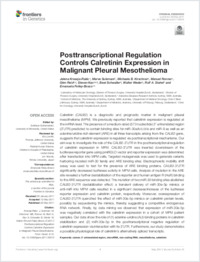Posttranscriptional regulation controls calretinin expression in malignant pleural mesothelioma
- Kresoja-Rakic, Jelena Laboratory of Molecular Oncology, Division of Thoracic Surgery, University Hospital Zurich, Switzerland
- Sulemani, Merve Laboratory of Molecular Oncology, Division of Thoracic Surgery, University Hospital Zurich, Switzerland
- Kirschner, Michaela B. Division of Thoracic Surgery, University Hospital Zurich, Switzerland
- Ronner, Manuel Laboratory of Molecular Oncology, Division of Thoracic Surgery, University Hospital Zurich, Switzerland
- Reid, Glen Asbestos Diseases Research Institute, Sydney, NSW, Australia - School of Medicine, The University of Sydney, NSW, Australia
- Kao, Steven Asbestos Diseases Research Institute, Sydney, NSW, Australia - School of Medicine, The University of Sydney, NSW, Australia - Department of Medical Oncology, Chris O’Brien Lifehouse, Sydney, NSW, Australia
- Schwaller, Beat Department of Medicine, Anatomy, University of Fribourg, Switzerland
- Weder, Walter Division of Thoracic Surgery, University Hospital Zurich, Switzerland
- Stahel, Rolf A. Clinic for Oncology, University Hospital Zurich, Zurich
-
2017
Published in:
- Frontiers in Genetics. - 2017, vol. 8, p. 70
English
Calretinin (CALB2) is a diagnostic and prognostic marker in malignant pleural mesothelioma (MPM). We previously reported that calretinin expression is regulated at the mRNA level. The presence of a medium-sized (573 nucleotide) 3′ untranslated region (3′UTR) predicted to contain binding sites for miR-30a/b/c/d/e and miR-9 as well as an adenine/uridine-rich element (ARE) in all three transcripts arising from the CALB2 gene, suggests that calretinin expression is regulated via posttranscriptional mechanisms. Our aim was to investigate the role of the CALB2-3′UTR in the posttranscriptional regulation of calretinin expression in MPM. CALB2-3′UTR was inserted downstream of the luciferase reporter gene using pmiRGLO vector and reporter expression was determined after transfection into MPM cells. Targeted mutagenesis was used to generate variants harboring mutated miR-30 family and ARE binding sites. Electrophoretic mobility shift assay was used to test for the presence of ARE binding proteins. CALB2-3′UTR significantly decreased luciferase activity in MPM cells. Analysis of mutation in the ARE site revealed a further destabilization of the reporter and human antigen R (HuR) binding to the ARE sequence was detected. The mutation of two miR-30 binding sites abolished CALB2-3′UTR destabilization effect; a transient delivery of miR-30e-5p mimics or anti-miR into MPM cells resulted in a significant decrease/increase of the luciferase reporter expression and calretinin protein, respectively. Moreover, overexpression of CALB2-3′UTR quenched the effect of miR-30e-5p mimics on calretinin protein levels, possibly by sequestering the mimics, thereby suggesting a competitive endogenous RNA network. Finally, by data mining we observed that expression of miR-30e-5p was negatively correlated with the calretinin expression in a cohort of MPM patient samples. Our data show the role of (1) adenine-uridine (AU)-binding proteins in calretinin stabilization and (2) miR-30e-5p in the posttranscriptional negative regulation of calretinin expression via interaction with its 3′UTR. Furthermore, our study demonstrates a possible physiological role of calretinin’s alternatively spliced transcripts.
- Faculty
- Faculté des sciences et de médecine
- Department
- Département de Médecine
- Language
-
- English
- Classification
- Biological sciences
- License
- License undefined
- Identifiers
-
- RERO DOC 288978
- DOI 10.3389/fgene.2017.00070
- Persistent URL
- https://folia.unifr.ch/unifr/documents/305773
Statistics
Document views: 90
File downloads:
- sch_prc.pdf: 120
